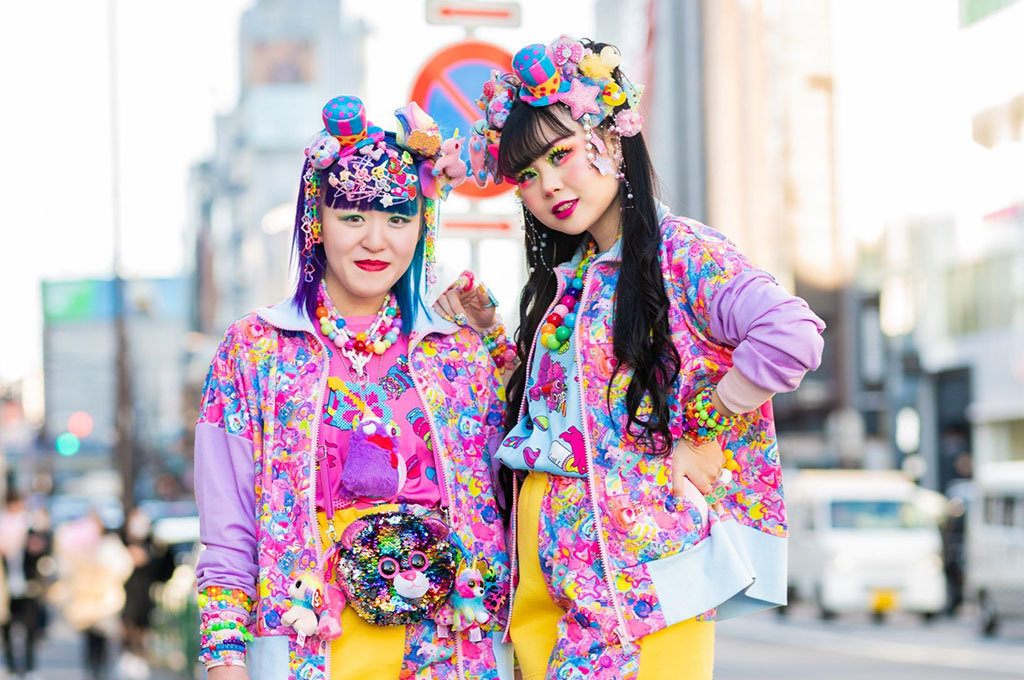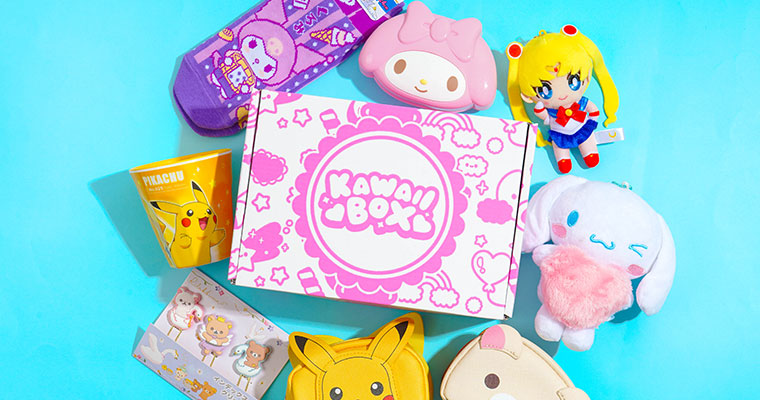If there’s one thing kawaii fans never get tired of, it’s Harajuku fashion. For decades, Harajuku district has been the heart of Japan’s most imaginative street style, sparking trends that zigzag across the globe. But Harajuku fashion isn’t just about what’s “in”—it’s about standing out, expressing yourself, and making magic out of everyday life.

What makes this style so iconic? Today, we’re walking down the streets of Harajuku to understand the color, history, and culture behind one of Japan’s most fearless fashion movements!
What Is Harajuku Fashion?
If you’ve ever seen someone rocking bright pink hair, layered tutus, plushie accessories, and combat boots all at once, you’ve already caught a glimpse of Harajuku fashion! It’s a bold and creative street style that started in the Harajuku district of Tokyo, Japan. Over the years, the area became known around the world as a center for experimental and eye-catching Japanese fashion.

What makes Harajuku fashion special? There are no rules! It celebrates individuality and self-expression, letting people dress however they want. You can mix and match bright colors, or go for an all-black lace outfit with kawaii accessories. Both are 100% Harajuku.

Harajuku fashion style isn’t just one look; it’s actually an umbrella term that includes lots of different subcultures and styles. From Kawaii Style and Decora Kei to Lolita and Fairy Kei, they’re all part of the Harajuku fashion world. Everyone is welcome to express their own version of style here because that’s what Harajuku fashion is all about!
When Did Harajuku Fashion Start?
Harajuku became a hotspot for fashion-forward youth in the 1970s when Japanese teens started gathering in the area to play with unique, alternative fashion. Things really took off when Laforet Harajuku, a trendsetting fashion building, opened in 1978. Suddenly, small designers had a space to shine, and young people had even more reasons to experiment with styles that blend Japanese and Western influences.

By the 1980s, Takeshita Street was the place to be for unique outfits and cool accessories. In the 1990s, photographer Shoichi Aoki created FRUiTS magazine, which was known for documenting the wild creativity of fashionable teens in and around Harajuku. Through this well-known magazine, Harajuku’s colorful style was shared with the world, and everyone wanted in!
What Does Harajuku Mean?

Before we dive into the ruffles, glitter, and oversized bows, let’s break down the name itself! “Harajuku” is written as 原宿 in Japanese. The first character, hara (原), means “field” while juku (宿) refers to a “post town” or “resting place.” So, it can translate to “a resting place in the fields.” Back in the Edo period, this area was literally a stopover for travelers along Japan’s busy roads.
Why Is It Called Harajuku?

Okay, so we know what the word means, but why did this Tokyo hotspot end up with such a meaningful name? After World War II, the U.S. military set up a camp in this very area in Japan. They built barracks and created a small Western-style town to house their soldiers and families. New shops popped up to serve the community—and boom! Harajuku started to evolve.

As Tokyo modernized, Harajuku stayed a little quirky, a little offbeat. This odd little city-within-a-city became a unique zone where different cultures mingled. Locals began to treat it like a safe space where they could take a break from the pressures of daily life and express themselves freely. It perfectly reflects the meaning of Harajuku.
Meet Harajuku Fashion’s Pop Princess!
Ever wondered who’s the most famous Harajuku fashion celebrity? That would be the one and only Kyary Pamyu Pamyu! Born Kiriko Takemura, this singer, model, and former fashion blogger literally rose from the colorful sidewalks of Harajuku to become the international face of kawaii style. From her cotton-candy wigs to her giant bows, Kyary doesn’t just wear Harajuku fashion—she is Harajuku fashion.

She first made waves as a model for iconic Harajuku magazines and quickly became known for her over-the-top Decora Kei looks. She also released song albums that are all about kawaii culture, which made way for her to be crowned “Harajuku Pop Princess.” In fact, in 2012, she was officially named “Kawaii Harajuku Ambassador” by the Mayor of Shibuya!
What to Wear in Harajuku

So, what should you wear in Harajuku? That’s the best part–you can wear anything you want! Japanese Harajuku style can be pastel and sugary sweet, dark and mysterious, or a wild combo of both. There are lots of Harajuku styles to get to know, and we’ll talk about that in our blog about all the types of Harajuku fashion styles.

Popular choices include kawaii character themes like Cinnamoroll and My Melody, layered skirts, statement bags, or gothic capes and lace. Futuristic styles are popping up too, with neon colors, shiny fabrics, and accessories inspired by anime and gaming. Harajuku fashion is like a giant dress-up box where no look is off-limits.
Want to add even more Harajuku cuteness to your life? Kawaii Box delivers Japan-only kawaii items like pastel plushies, cute accessories, and dreamy stationery straight to your door!
How Has Harajuku Fashion Changed?

Back in the early days of Harajuku fashion, most people picked one style tribe and stuck to it. People often devoted themselves to one aesthetic from head to toe, down to the tiniest accessories. The streets of Harajuku were like a live-action fashion show, with each person proudly showing their chosen style.

But today? Things are a lot more flexible. Instead of following one strict fashion code, younger generations are creating their own style languages by mixing and matching different genres. You might see someone in a frilly pastel skirt paired with chunky sneakers and a mecha-anime backpack—because why not?
The community has also shifted. While Takeshita Street is still buzzing, the street isn’t quite as overflowing with bold fashion every single day like it was in the early 2000s. Many Harajuku lovers now express their style online, through Instagram, TikTok, or fashion communities.
Harajuku Fashion Is for Everyone!

One of the most magical things about Harajuku fashion is that there are no rules about who can wear it. It doesn't matter how old you are, where you're from, or what your style has been before. If you love to express yourself through clothing, then you already belong in the world of Harajuku.

Anyone can rock it—boys, girls, nonbinary friends, everyone in between! If a guy wants to wear pastel skirts and glittery bows? Go for it. If someone loves darker tones with lace and platform boots? That’s Harajuku too. Fashion here is fluid, expressive, and all about what makes you feel amazing.
Is Harajuku Fashion Really Dead?

No, don’t believe what some headlines say! Harajuku is far from dead. Just because the Harajuku streets aren’t as filled with colorful styles as before doesn’t mean the Harajuku spirit is gone! If anything, Harajuku fashion is simply transforming, like it always has. Harajuku is still a safe space where people can express themselves without limits—and that’s something that never goes out of style.
Where to See Harajuku Fashion

Of course, the most obvious place to see Harajuku fashion is the Harajuku district, specifically Takeshita Street, the heart of it all. But Harajuku fashion isn’t limited to just one Tokyo neighborhood anymore. You can now spot Harajuku-inspired outfits all over Japan, from the vintage shops of Shimokitazawa to the trendy corners of Osaka’s Amerikamura.

And let’s not forget the power of the internet! Thanks to Instagram, TikTok, and street fashion blogs, you can scroll through Harajuku looks from anywhere in the world. Global fans in places like the U.S., Europe, and Singapore are rocking their own versions of Harajuku style, often blending it with their local fashion culture.
Where to Buy Kawaii Harajuku Fashion

Dreaming of getting the Harajuku aesthetic? You’re in luck, as there are so many places to shop for it! The best place to start is Takeshita Street in Harajuku itself. This legendary shopping street is lined with Harajuku fashion shops. One of the most iconic spots is Laforet Harajuku, where you’ll find everything from kawaii hair goods to platform shoes.

Not in Japan? Don’t worry—Harajuku fashion has fans all over the world, and many stores now ship internationally! Check out famous Japanese Harajuku fashion brands like 6% DOKIDOKI, Angelic Pretty, ACDC Rag, and Tokyo Rebel. These shops often carry pieces from well-known brands and even host pop-ups and events for local J-fashion communities.

And that’s a wrap on our Harajuku adventure! Harajuku style is all about expressing who you are without limits. No matter the mood, it’s always creative, always personal, and always fun.

Ready to explore your own Harajuku style? Or have you already tried one? Drop a comment below and tell us all about it!








